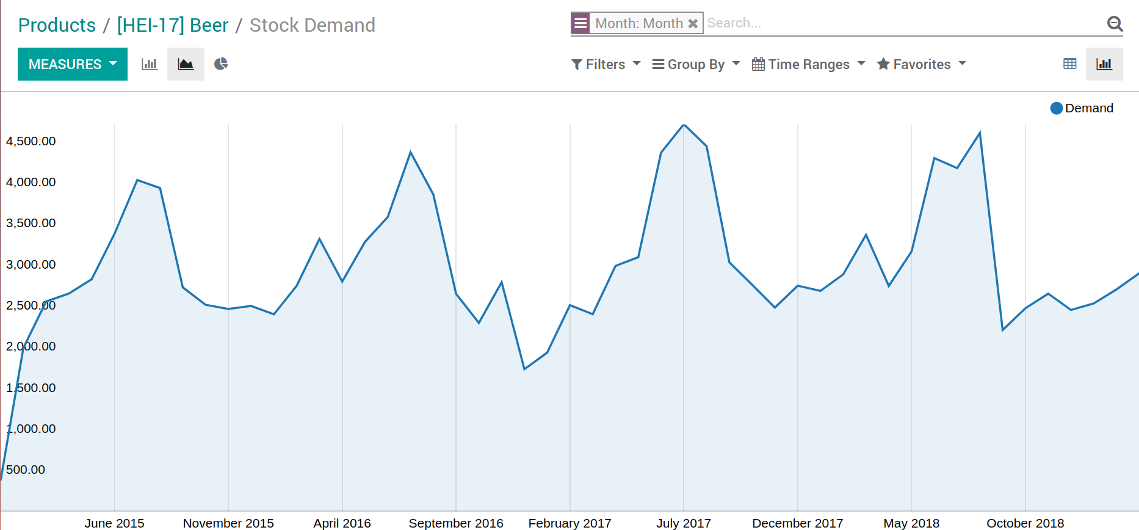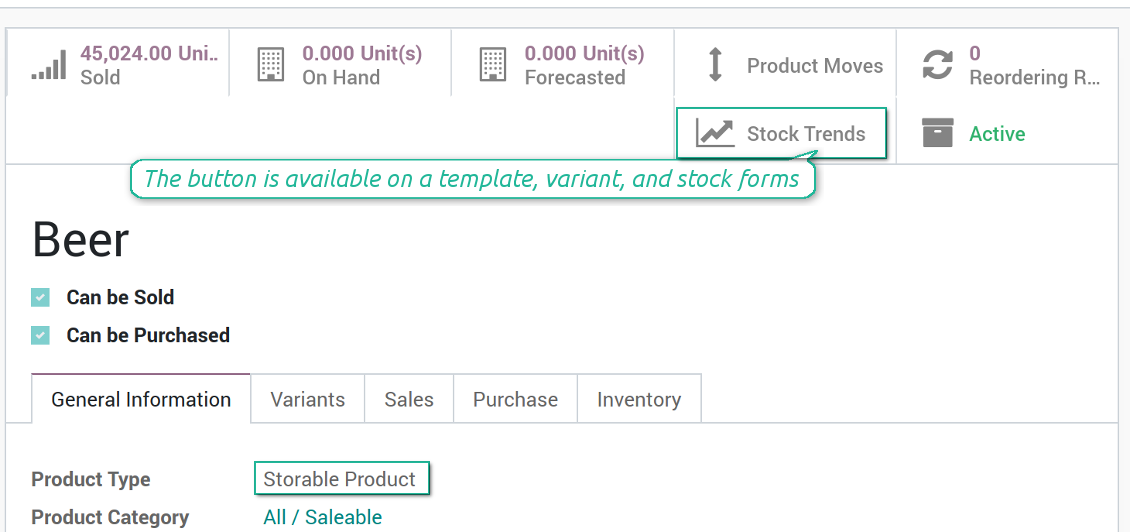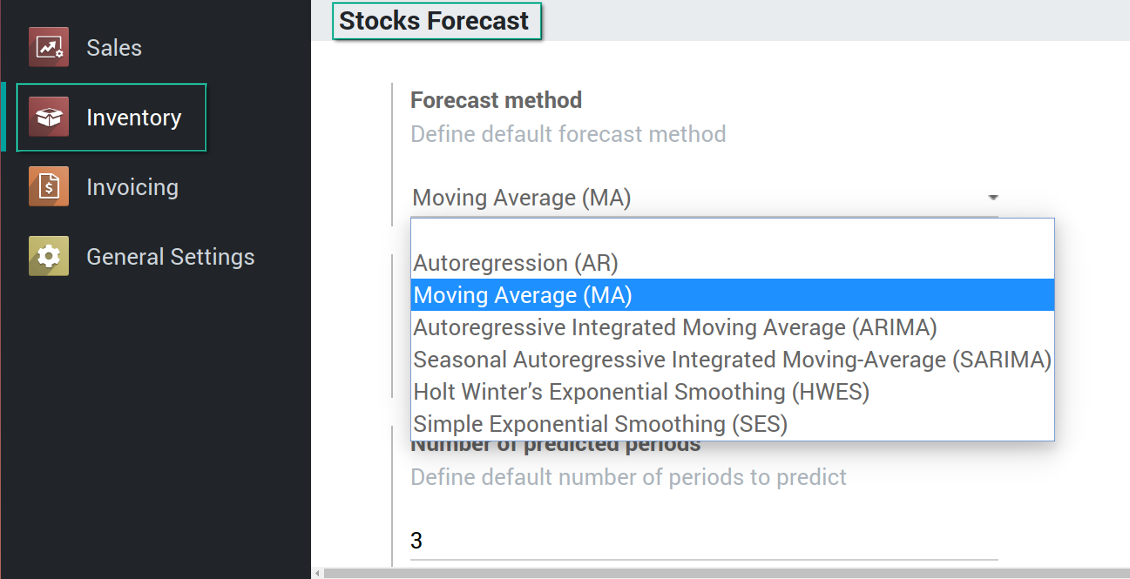Stock Demand Trends and Forecast v.12
The tool to calculate stock demand trends and make prediction for future demand statistically. Stock Forecast
When this tool should be used
- You have enough historical stock demand data (per location or company), since it is senseless to make forecast based on last 5 days of operations.
- Stock demand is regular and is not chaotic, meaning that your decisions do not have 100% impact and there is at least some correlation between market demand and your WMS operations.
- You consider seasonal changes and/or trends, which you noticed but can't fully analyze. You understand which assumptions you try to check.
- You have clear understanding how statistics works.
Stock demand forecasting interface
The right for trends analysis might be granted to any WMS user, but be cautious: all stock moves of a current company will be under consideration.
Screenshots
Stock demand trends and forecast chart

Stock demand trends and forecast as an xlsx table

Odoo pivot view of stock trends and forecast

Stock demand forecast in a few clicks

Grant the right for the forecast report

Scientific approach for forecasting
Forecast as many intervals as you like, but remember that prediction for the next 10 years would be hardly reliable.
Based on your historical data and applied coefficients, sometimes Odoo is not able to reveal trends and make forecasts. In that case only historical data would be shown in reports. But even historical trends might have analytical use.
Statistical methods for forecast
Autoregression (AutoReg)
It is the simplest but still widely used statistical method for time series forecast.
Autoregressive Distributed Lag (ARDR)
The moving average method takes into account 'errors' in previous observations.
The autoregressive moving average method is a combination of both AR and MA methods. To apply the ARMA method use the MA method with auto regression coefficient (P coefficient) as 2
Autoregressive Integrated Moving Average (ARIMA)
The method which also combines the methods AR and MA, but also tries to make data stationary. It is appropriate to use for historical data with pure trend but without seasonal changes.
Seasonal Autoregressive Integrated Moving-Average (SARIMA)
The SARIMA method enriches the ARIMA method with considering seasonal changes. It is one of the most complex and wide spread methods utilized for forecasting time series now
Simple Exponential Smoothing (SES)
The SES model usage is similar to the AR method, but instead of relying upon linear function, it exploits exponential one
Holt Winter’s Exponential Smoothing (HWES)
The HWES method enriches the SES method to work with time series trends and seasonal effects.
Screenshots
Experiment with various statistical models

Topical data under consideration
Make analysis per the whole company or per a definite location. In the latter case optionally include or exclude child locations.
Apply time frames of historical data which is used as an analytic basis. Forecast periods are ones which follow after the end of defined frame. In such a way you make check statistical reliability 'predicting' actually passed intervals.
Stock demand is calculated as all done stock moves for this period which source location is one of internal location under consideration and which destination location is not of this range.
Screenshots
Target your analysis by locations

Configuration and Installation Tips for Stock Demand Trends and Forecast Odoo v.12
Python dependencies
To guarantee tool correct work you would need a number of Python libraries: pandas, numpy, statsmodels, scipy, xlsxwriter. To install those packages execute the command:
pip3 install pandas numpy statsmodels scipy xlsxwriter
If you run Odoo on Python prior or equal to version 3.7, please install the following versions of the packages pandas==1.3.5, statsmodels==0.13.1
Default values
Demand trends and forecast configuration

Bug reporting
In case you have faced any bugs or inconsistent behavior, do not hesitate to contact us. We guarantee to provide fixes within 60 days after the purchase, while even after this period we are strongly interested to improve our tools.
No phone number or credit card is required to contact us: only a short email sign up which does not take more than 30 seconds.
Please include in your request as many details as possible: screenshots, Odoo server logs, a full description of how to reproduce your problem, and so on. Usually, it takes a few business days to prepare a working plan for an issue (if a bug is confirmed) or provide you with guidelines on what should be done (otherwise).
Public features requests and module ideas (free development)
We are strongly motivated to improve our tools and would be grateful for any sort of feedback. In case your requirements are of public use and might be efficiently implemented, the team would include those in our to-do list.
Such a to-do list is processed on a regular basis and does not assume extra fees. Although we cannot promise deadlines and final design, it might be a good way to get desired features without investments and risks.
No phone number or credit card is required to contact us: only a short email sign up which does not take more than 30 seconds.
The technical core to synchronize your cloud storage solution with Odoo
379€The tool to build deep and structured knowledge base for internal and external use. Knowledge System. KMS
298€The tool for time-based service management from booking appointment to sale and reviews
398€The tool to automatically synchronize Odoo attachments with OneDrive files in both ways
468€The tool to configure variant prices based on attributes coefficients and surpluses
98€The tool to administrate vendor data about products, prices and available stocks
98€